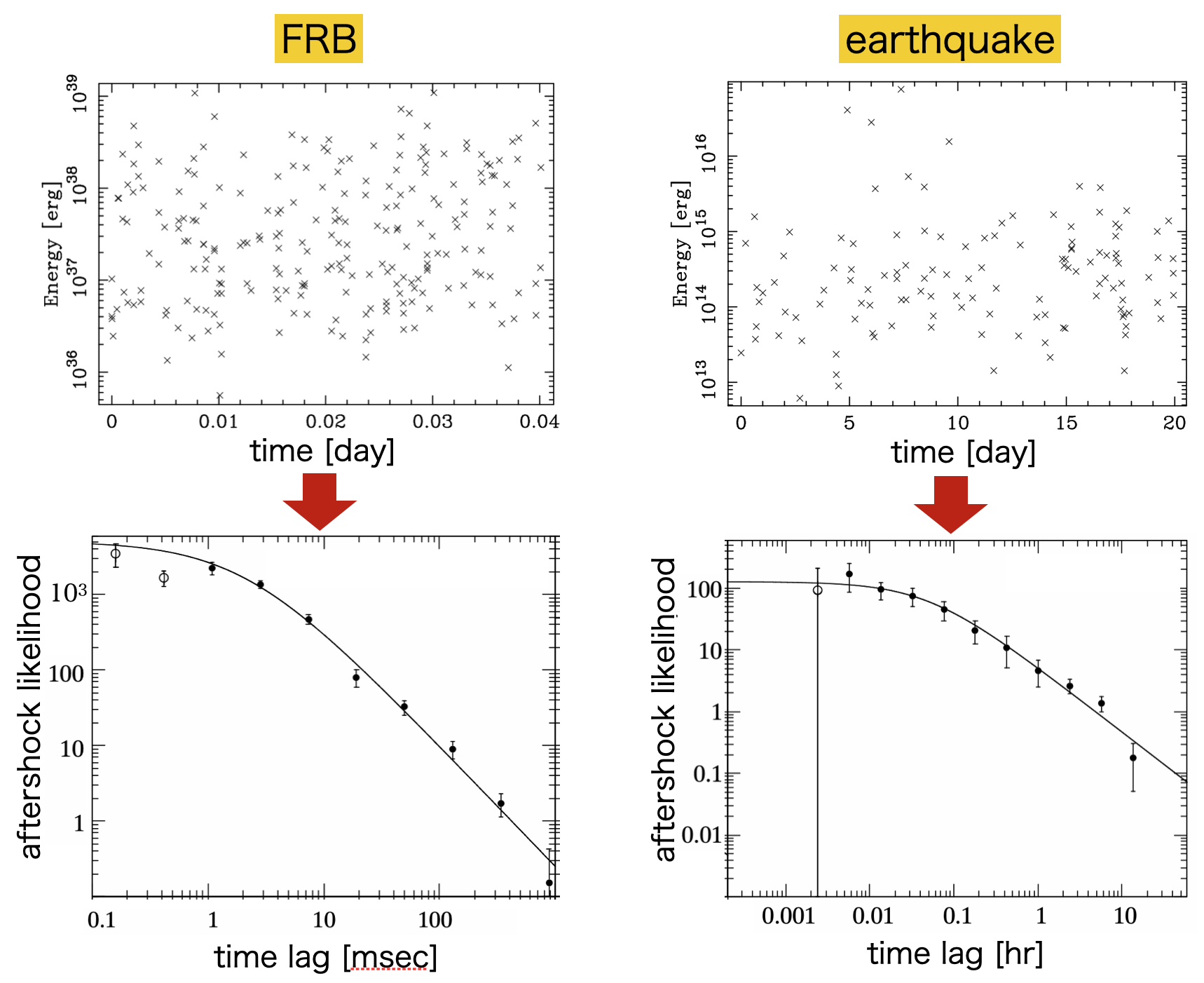Disclaimer: machine translated by DeepL which may contain errors.
Evidence for "starquakes" on neutron stars?
Tomonori Totani, Professor, Department of Astronomy
"Fast radio bursts" are now attracting attention in astronomy.
These are mysterious explosions that glow in radio waves for only a few milliseconds.
Recent progress has revealed that they apparently occur in neutron stars.
So how do explosions occur on neutron stars?
There is a solid crust on the surface of a neutron star, and it has long been discussed that a destructive phenomenon similar to earthquakes may occur.
This time, a closer look at the "aftershocks" of fast radio bursts revealed
that they are remarkably similar to Earth's earthquakes.
This result strongly suggests that earthquakes occur on space bodies other than Earth.
![]()
In radio astronomy, which uses radio waves (electromagnetic waves with wavelengths much longer than those of visible light) used for communication and other purposes to observe the universe, a new type of astronomical phenomenon was first reported in 2007: high-speed radio bursts. These bursts occur outside our own galaxy, billions of light years away from us, and at least some of them are repeated many times.
The most likely origin is neutron stars. Neutron stars are the result of the gravitational collapse of a star more than eight times heavier than the Sun and the supernova explosions that follow. Neutron stars have intense magnetic fields of 100 million Tesla or more, which rise up from the center and distort and sometimes destroy the solid crust. It has long been theoretically predicted that such "starquakes," which are not earthquakes, might occur.
If so, then, could fast radio bursts, like earthquakes, also have "aftershocks," in which one event triggers the next one? With this idea in mind, I investigated the time correlation between events of fast radio bursts and found that aftershocks do indeed occur, with the rate of occurrence decaying as a power of time. This "decay by a power of" is the same as the Omori-Uzu law, which has been known for a long time in the field of earthquakes. The word "aftershock" conjures up an image of a large earthquake followed by many small earthquakes, but in fact, even if we focus on individual events, we can find aftershocks that follow the Omori-Uzu law with a certain probability after each event. In fact, when we applied our correlation function analysis method to Japanese seismic data, we obtained results similar to those of fast radio bursts. In particular, the probability of an aftershock occurring after an event was also similar between 10 and 50% for the two phenomena. Incidentally, we also analyzed solar flares, another phenomenon that is often compared, and found no similarity with fast radio bursts or earthquakes. This may be because the surface of the sun is fluid and there is no solid crust.
 Top: Distribution of occurrence time and energy of fast radio bursts and earthquakes. Bottom: Correlation function of occurrence time (likelihood of aftershocks) as a function of time interval between aftershocks. Both decay to powers of a power in regions longer than the typical duration of the phenomena (a few milliseconds for fast radio bursts and a few minutes for earthquakes).
Top: Distribution of occurrence time and energy of fast radio bursts and earthquakes. Bottom: Correlation function of occurrence time (likelihood of aftershocks) as a function of time interval between aftershocks. Both decay to powers of a power in regions longer than the typical duration of the phenomena (a few milliseconds for fast radio bursts and a few minutes for earthquakes).
It was surprising to find such similarities between neutron stars and the Earth, which differ in scale by tens of orders of magnitude and have completely different constituent materials. Further theoretical investigation of this similarity is expected to provide new insights into the generation mechanism of fast radio bursts and the properties of the ultra-dense matter of neutron stars. The author is not an expert on earthquakes, but it seems that the theoretical understanding of the Omori/Utsunori law of earthquakes is not yet sufficient. The fact that a phenomenon similar to earthquakes is observed in a completely different place, a neutron star, may shed new light on the understanding of aftershocks of earthquakes by reviewing the phenomenon as a more universal phenomenon. I am excited that this research will likely develop in various directions in the future.
This study was published in T. Totani and Y. Tsuzuki, Monthly Notices of the Royal Astronomical Society, 526, 2796, (2023).
(Press release October 12, 2023)
Published in The Rigaku-bu News, January 2024
Frontiers of Science for Undergraduates


